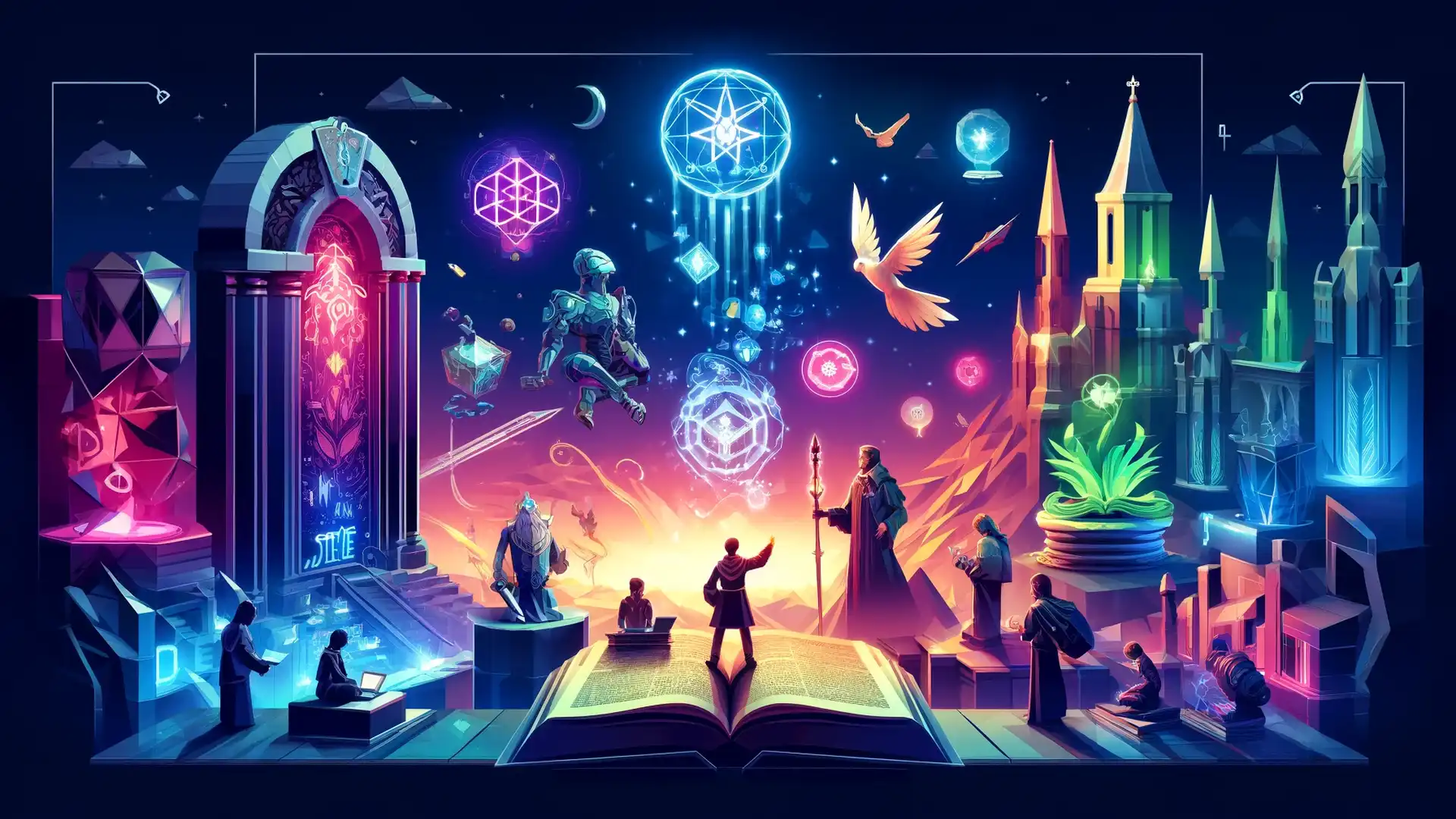NFT Credentials Accessibility: Making Education Open to All

 Author:
Artem Grigoriev
Author:
Artem Grigoriev
Bridging Access: The Role of NFT Credentials in the Transformative World of Education
Imagine a world where your hard-earned academic achievements are not only securely stored but also easily shareable. They would be universally recognized as well. This visionary promise is brought to life by Non-Fungible Tokens (NFTs) —unique digital certificates—within the educational sector. NFTs harness the power of blockchain technology , a method of recording information that makes it difficult or impossible to alter, hack, or cheat the system.
📘 This article complements: "The Complete Guide to NFT Credentials". Explore it to find answers to all your questions;)
This promises a transformative shift in how educational credentials are managed and recognized globally. It dismantles traditional barriers and provides a seamless bridge between learners and educational opportunities. This happens regardless of geographic or socioeconomic constraints.
The core strength of NFT credentials lies in their decentralization . This means the distribution of control away from a central authority. Unlike conventional credentials, which depend on centralized institutions for validation, NFTs exist within a robust blockchain network. This ensures transparency through guaranteed visibility and trackability of all transactions. Security is significantly enhanced, protecting information from unauthorized access.
Immutability —the inability to alter recorded data—ensures that once an educational achievement is securely recorded on a blockchain, it becomes a permanent, verifiable record that cannot be altered or forged. Such robust security features greatly enhance trust in the authenticity of credentials. A recent study from Cornell University highlights the reduced potential for fraud in systems utilizing blockchain technology. This is due to its cryptographic security measures Study by Cornell University .
This revolutionary technology also drastically reduces administrative burdens . It cuts down the time and resources spent on paperwork and processes. It reduces costs associated with issuing and verifying physical or traditional digital credentials. Schools, colleges, and universities can issue blockchain-based credentials that are instantly verifiable. This reduces the need for intermediaries and streamlines the accreditation process.
This efficiency not only saves time but also vital resources. It makes education more accessible and affordable, especially in underserved regions. Experts estimate that blockchain could cut credentialing costs by up to 70%, making higher education more accessible Blockchain in Education .
💡 Note: Blockchain technology not only secures credentials against tampering but also facilitates their instant verification across the globe. This eliminates the cumbersome process of validation through third parties and long back-and-forth communication.

The successful implementation of NFT credentials requires educational institutions to adopt certain key technical infrastructures. This includes digital wallets —applications that allow users to store and manage their digital assets—and robust blockchain networks. Ensuring these platforms are user-friendly and accessible from various devices and at different internet speeds is crucial. This inclusive approach helps level the playing field. It allows students from diverse backgrounds—including those from low-income families or remote areas—to fully participate in educational opportunities.
Moreover, the inherent flexibility of NFTs caters to the unique needs of marginalized groups and individuals with disabilities. It enables customizable learning experiences. Learning aids and academic records can be easily updated or modified to reflect current educational achievements or special requirements. This promotes a truly inclusive educational system.
However, the shift to blockchain-based credentialing isn't without its challenges. There is a pressing need for universal digital access to ensure everyone can use digital technologies. Robust policy and regulatory frameworks —rules and guidelines established to govern the use of these technologies—are also essential. Establishing global standards and legal frameworks is crucial to mitigate risks associated with privacy, fraud, and the digital divide. The ethical considerations of implementing such technologies must also be thoroughly addressed. This ensures they enhance educational access rather than exacerbate existing inequalities.
Ongoing research and pilot programs (small-scale preliminary studies) are critical for testing and refining NFT applications in education. Collaborations with technology providers and educational consortia can help develop best practices and scalable solutions. As more institutions adopt NFT credentials, a collective effort to share insights and outcomes will be invaluable in advancing the field and overcoming common obstacles.
In conclusion, the integration of NFTs into the educational sector offers significant advantages. These include enhanced security, efficiency, and inclusivity. However, it necessitates careful consideration of the technological, legal, and ethical frameworks required to support such a transformative shift.
💡 Tip: Institutions considering the adoption of NFT credentials should begin by forming task forces—groups of people assigned specific tasks—to evaluate technical requirements and potential barriers. Engaging with all stakeholders, including students, educators, and technologists, will be key in designing an inclusive system that harnesses the full potential of blockchain technology. Additionally, pilot programs and partnerships with blockchain experts can provide practical insights. This helps to mitigate implementation challenges and ensures a smoother transition to this innovative credentialing system.

NFTs in Action: Case Studies and Future Perspectives in Enhancing Educational Accessibility
The introduction of Non-Fungible Tokens (NFTs) —unique digital assets verified using blockchain technology to ensure their authenticity and ownership—into the educational landscape is not just theoretical. It's becoming increasingly practical. This chapter delves into several compelling case studies, showcasing how NFT credentials are actively reshaping educational access and inclusivity. These real-world applications powerfully demonstrate the revolutionary potential of blockchain technology, creating a more decentralized (distributed control rather than centralized) and interoperable (able to work across different systems) educational system.
One standout example comes from a university in Asia. It has successfully launched an NFT system to issue and verify diplomas for its graduates. This initiative has significantly reduced the time and cost associated with credential verification. It allows alumni to seamlessly pursue global career opportunities without bureaucratic delays.
Similarly, a vocational school in Africa has embraced NFT-based micro-credentials . It empowers its students with small, stackable tokens of achievement recognized by both local and international employers. Micro-credentials are smaller units of learning, like certificates for specific skills, that can be combined over time to build up qualifications. Such examples underscore the global reach and practical benefits of NFTs in education, as reported by EdTechReview .
These case studies effectively highlight the scalability (ability to handle growing amounts of work) and adaptability (ability to change and fit different needs) of NFT technology. They help overcome traditional educational barriers, such as geographical isolation and limited access to accredited institutions. The decentralized nature of blockchain allows for credentials that are universally recognizable and transferable across borders.
This enables a global educational network. It promotes lifelong learning and professional development, particularly benefiting learners in regions with limited educational infrastructure. It offers a pathway to internationally recognized qualifications without the need for physical relocation.
Innovative methodologies emerging from NFT integration are actively transforming educational paradigms. For instance, gamified learning experiences —using game-like elements to make education more engaging and fun—are being enhanced with NFTs. These reward educational milestones with digital assets. These rewards can be displayed in digital portfolios, providing tangible evidence of achievement.
Additionally, the concept of micro-credentialing is rapidly gaining traction. It offers learners the ability to accumulate and present smaller units of learning directly relevant to specific career paths or interests. This movement towards modular education reflects a significant shift in how educational achievements are recognized and valued. It suggests a future where education is more customized and responsive to the needs of the job market.
💡 Note: The ability of NFTs to support scalable and adaptable educational models demonstrates their potential to democratize access to education. It makes education accessible to more people, regardless of their circumstances, especially underprivileged or remote populations.

Looking forward, the chapter explores the broader implications of NFTs in enhancing global education accessibility. For example, NFTs could provide crucial support to refugee populations . These individuals often struggle to verify their academic records when displaced. By securing their credentials on a blockchain, these individuals can maintain control over their educational documents. This facilitates easier access to employment and further education globally.
Similarly, remote indigenous communities could leverage NFT-based platforms to access a wider range of educational resources. This fosters greater educational equity. Additionally, the use of NFTs could support continuous professional development. This allows individuals to accumulate credentials over a lifetime, enhancing their employability and career advancement opportunities.
However, the environmental impact of blockchain, the foundational technology for NFTs, poses a significant challenge. Blockchain networks, particularly those using proof-of-work (PoW) consensus mechanisms—methods used to validate transactions and secure the network—can consume a lot of energy. The chapter addresses the strides being made in developing more eco-friendly blockchain solutions that reduce the energy consumption associated with NFT transactions.
These advancements are crucial for ensuring that the push for digital credentialing does not exacerbate global carbon emissions. Initiatives such as transitioning to proof-of-stake (PoS) consensus mechanisms, which are more energy-efficient, and exploring renewable energy sources for blockchain operations are highlighted as potential solutions.
Moreover, the need for robust regulatory and legal frameworks —rules and guidelines established to govern the use of these technologies—is discussed. This ensures that these technologies do not infringe on privacy or lead to misuse. As NFTs become more integrated into educational systems, it is imperative that regulations evolve to protect users while fostering innovation.
Establishing international standards and cooperation between governments and educational institutions is essential. This addresses issues such as data privacy, intellectual property rights, and cross-border recognition of credentials.
In sum, while the journey of integrating NFTs into education shows promising early successes, it also presents a landscape filled with challenges that need careful navigation. The potential for creating an accessible, equitable, and environmentally conscious educational framework is immense. This requires a concerted effort from technologists, educators, and policymakers alike. Ongoing dialogue and collaboration among these stakeholders will be crucial in realizing the full benefits of NFTs in education.
💡 Tip: Educational institutions looking to implement NFT-based systems should prioritize partnerships with technology providers committed to sustainable practices. They should understand the regulatory landscapes of the regions they serve. Engaging with academic researchers and industry experts can provide valuable insights. This helps to understand best practices and emerging trends in NFT applications within the educational sector. This means working with those who are knowledgeable about both the technology and the rules that govern its use, ensuring a smooth and responsible implementation.

Applying NFTs in Professional Training, Certification, and Accreditation
Enhancing Alumni Engagement Through NFT Credentials
Global Recognition of NFT Credentials and the Role of TTP
Why NFT Credentials Are the Best Solution for International Students
Multilingual Support and Cultural Adaptation of NFT Credentials
